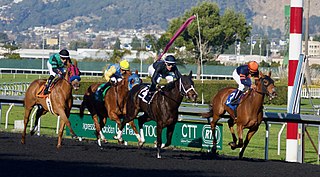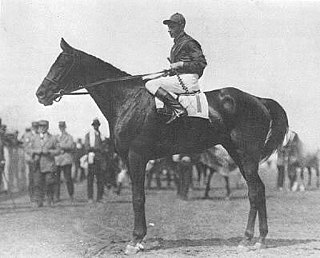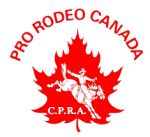Related Research Articles

The Triple Crown of Thoroughbred Racing, often shortened to Triple Crown, is a series of horse races for three-year-old Thoroughbreds. Winning all three of these Thoroughbred horse races is considered the greatest accomplishment in Thoroughbred racing. The term originated in mid-19th-century England and nations where Thoroughbred racing is popular each have their own Triple Crown series.

Thoroughbred racing is a sport and industry involving the racing of Thoroughbred horses. It is governed by different national bodies. There are two forms of the sport – flat racing and jump racing, the latter known as National Hunt racing in the UK and steeplechasing in the US. Jump racing can be further divided into hurdling and steeplechasing.

Northern Dancer was a Thoroughbred who, in 1964, became the first Canadian-bred horse to win the Kentucky Derby. He then became one of the most successful sires of the 20th century. He is considered a Canadian icon and was inducted into the Canadian Sports Hall of Fame in 1965. Induction into the Racing Hall of Fame in both Canada and the United States followed in 1976. As a competitor, The Blood-Horse ranked him as one of the top 100 U.S. Thoroughbred racehorses of the 20th century. As a sire of sires, his impact on the breed is still felt worldwide.

Horse racing is an equestrian performance sport, typically involving two or more horses ridden by jockeys over a set distance, for competition. It is one of the most ancient of all sports, as its basic premise – to identify which of two or more horses is the fastest over a set course or distance – has been unchanged since at least classical antiquity.

Harness racing is a form of horse racing in which the horses race at a specific gait. They usually pull a two-wheeled cart called a sulky, or spider, occupied by a driver. In Europe, and less frequently in Australia and New Zealand, races with jockeys riding directly on saddled trotters are also conducted.

Exterminator was an American Thoroughbred Hall of Fame racehorse, the winner of the 1918 Kentucky Derby and in 1922 Horse of the Year honors.
James E. Day was a Canadian Olympic equestrian show jumping champion and Thoroughbred horse trainer.
The Delaware Oaks Stakes is an American Thoroughbred horse race run annually in mid July at Delaware Park Racetrack in Stanton near Wilmington, Delaware.
Josie Carroll is a Canadian Thoroughbred horse trainer, who in 2006 became the first woman trainer to win the Queen's Plate, the oldest thoroughbred horse race in Canada and Canada's most prestigious race. She also won the Queen's Plate in 2011 and 2020, the Prince of Wales Stakes in 2016 and 2020, and the Breeder's Stakes in 2014
Harold Clifford "Harry" Hatch (1884–1946) was a self-made millionaire industrialist from Prince Edward County, Ontario specializing in the business of wine and spirits.
Glorious Song (1976–2003) was a Hall of Fame Thoroughbred racehorse who was a Champion in Canada and the United States and became an important broodmare. Bred by the prominent horseman E. P. Taylor at his Windfields Farm in Oshawa, Ontario, she was sired by Halo and out of the mare Ballade, who also produced U.S. Champion Devil's Bag.

Bull Lea was an American Thoroughbred racehorse who is best known as the foundation sire responsible for making Calumet Farm one of the most successful racing stables in American history. In their article on Calumet Farm, the International Museum of the Horse in Lexington, Kentucky wrote that Bull Lea was "one of the greatest sires in Thoroughbred breeding history."
Flaming Page was a Canadian Thoroughbred who was a Champion racehorse and then an outstanding broodmare. She is best known as the dam of English Triple Crown winner Nijinsky. She was elected to the Canadian Horse Racing Hall of Fame in 1980.
Robert B. "Bobby" Watson (1913–1997) was a Canadian Horse Racing Hall of Fame jockey. He was born in Aberdeen, Scotland, the son of Helen Booth and her husband, Alexander Watson. In his youth, the family emigrated to Canada where they settled in the city of Toronto, Ontario where Alexander Watson became involved in Thoroughbred racing. Alexander's sister, Georgina, married Ross Robertson, and they too emigrated to the United States. Their son, Alfred Robertson, was also a highly successful jockey who was inducted in the U.S. Racing Hall of Fame.
The Canadian Triple Crown is a series of three Thoroughbred horse races run annually in Canada which is open to three-year-old horses foaled in Canada. Established in 1959, the series is unique in that it shares the same distances as its American counterpart but is contested on three different track surfaces.

In the United States, the Triple Crown of Thoroughbred Racing, commonly known as the Triple Crown, is a series of horse races for three-year-old Thoroughbreds, consisting of the Kentucky Derby, Preakness Stakes, and Belmont Stakes. The three races were inaugurated in different years, the last being the Kentucky Derby in 1875. The Triple Crown Trophy, commissioned in 1950 but awarded to all previous winners as well as those after 1950, is awarded to a horse who wins all three races, and is thereafter designated as a Triple Crown winner. The races are traditionally run in May and early June of each year, although global events have resulted in schedule adjustments, such as in 1945 and 2020.
Douglas Allan Dodson was a Champion jockey in American Thoroughbred horse racing.
Thomas Joseph Kelly was a United States Racing Hall of Fame trainer of Thoroughbred racehorses as well as an owner and breeder.
Chop Chop (1940-1963) was an American Thoroughbred racehorse who was inducted in the Canadian Horse Racing Hall of Fame. He was sired by Flares, a son of U.S. Triple Crown winner Gallant Fox and a full brother to U.S. Triple Crown winner Omaha. Flares raced in England with considerable success for owner William Woodward Sr., counting the Ascot Gold Cup, Champion Stakes and Princess of Wales's Stakes among his wins.

The Canadian Professional Rodeo Association (CPRA) is the governing body of professional rodeo in Canada. Its championship event is the Canadian Finals Rodeo (CFR) held every November. The CPRA also tracks its champions in the List of Canadian Rodeo Champions and its hall of fame inductees in the List of Canadian Pro Rodeo Hall of Fame Inductees.